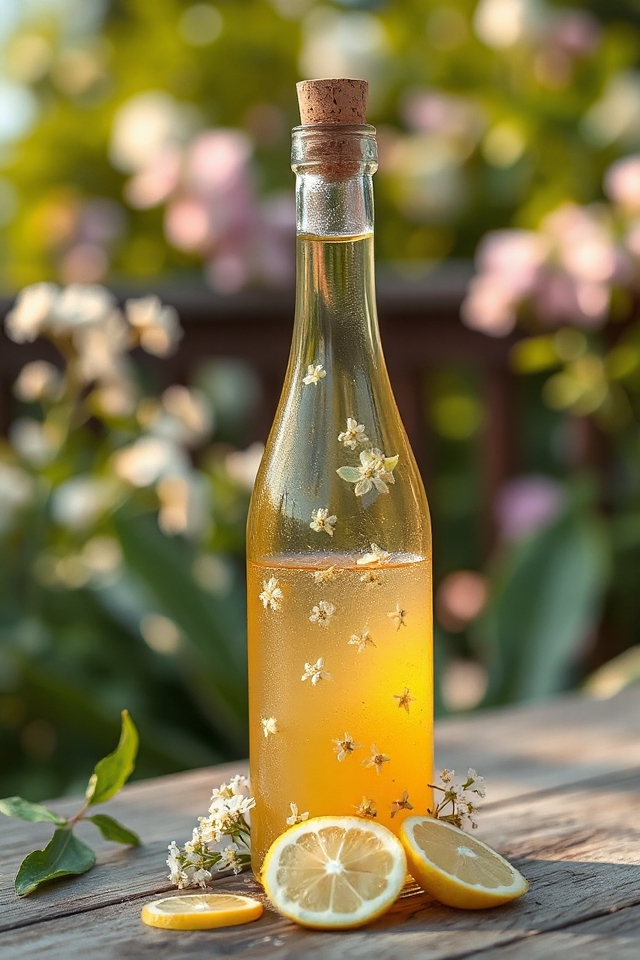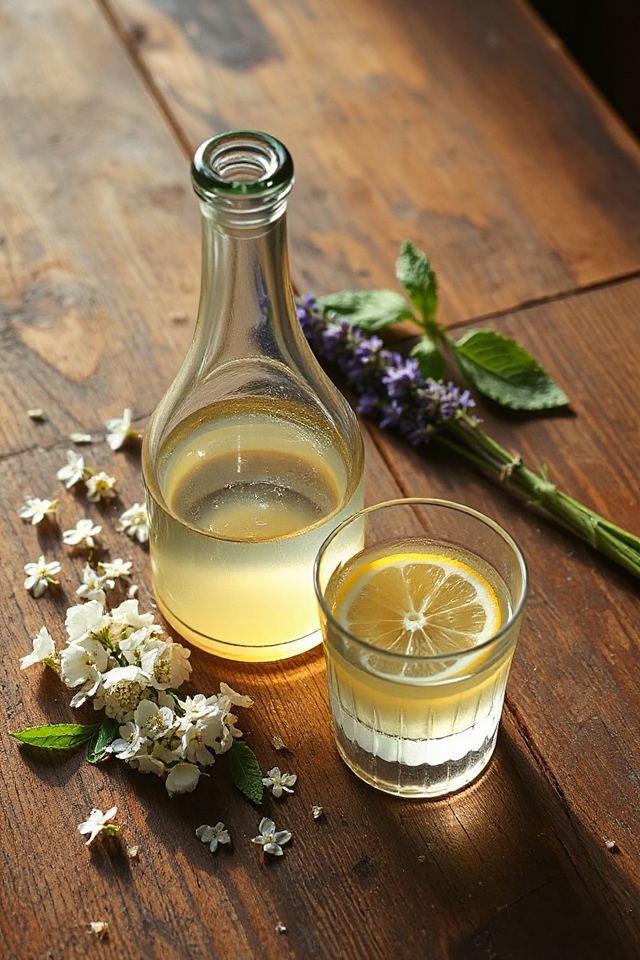Why You’ll Love This Elderflower Liqueur Recipe
If you’re looking for a unique and revitalizing addition to your home bar, you’ll absolutely love this elderflower liqueur recipe. The fragrant, floral notes of elderflower create a delightful liqueur that transforms any cocktail.
I’ve found it’s perfect for sipping straight or mixing into invigorating drinks. Plus, the vibrant color adds an inviting touch to your glass.
Making your own liqueur feels rewarding, and it’s a fantastic conversation starter when friends come over. You can impress them with your homemade creation while sharing the story behind it.
Trust me, once you try it, you’ll want to make it again and again!
Ingredients of Elderflower Liqueur
Making your own elderflower liqueur is like crafting a little bottle of sunshine. The ingredients are quite simple, but they come together to create something truly special.
Plus, let’s be honest, who wouldn’t want to impress friends with a homemade concoction that feels fancy but is surprisingly easy to whip up? You’ll be the talk of the town—or at least the talk of the next gathering.
So, let’s gather up our ingredients and get started on this delightful adventure.
Here’s what you’ll need to make your very own elderflower liqueur:
- Elderberry flowers (enough to loosely fill a quart mason jar; shake off any bugs and remove toxic stems)
- Vodka or Everclear (100-proof or higher)
- 1/4 to 1/2 cup sugar (depending on your sweetness preference)
- 3-4 lemon verbena leaves (or lemon slices if you prefer)
Now, before you plunge into the mixing and mingling, there are a few things to keep in mind about the ingredients.
First off, make sure those elderflower blossoms are fresh and free from any pesky bugs—trust me, no one wants a crunchy surprise in their drink.
When it comes to alcohol, the higher the proof, the better the extraction of those beautiful floral flavors, but if you prefer a milder taste, vodka works just fine.
And let’s not forget the sugar; you can always start with less and add more later. It’s all about getting that perfect balance that tickles your taste buds.
How to Make Elderflower Liqueur

Creating your very own elderflower liqueur isn’t just a recipe; it’s an experience that transforms those delicate little flowers into something magical.
First things first, gather your elderberry flowers—enough to loosely fill a quart mason jar. Take a moment to give them a good shake to dislodge any sneaky bugs, and remember to remove any toxic stems. We want this concoction to be delightful, not a game of botanical roulette.
Once you’ve got your flowers in the jar, it’s time for the star of the show: the alcohol. Pour in enough vodka or Everclear (100-proof or more is ideal) to completely cover those blooms. You want to make sure no air bubbles are lurking, as they can spoil your floral party. If you’re feeling fancy, you can even place a smaller jar upside down on top of the flowers to keep them submerged.
Now that you’ve got your jar looking all magical, close it tightly and find a cool, dark spot to let your mixture work its magic. Give it a shake every day for at least a week, but if you’re patient (unlike me, who tends to peek too often), letting it steep for a month will yield even better results.
After that, it’s time for a little filtering action. Strain the mixture a couple of times, using an unbleached coffee filter for the second pass to make certain it’s crystal clear. You don’t want any floaties ruining your Instagram moment, right?
Once it’s all strained, it’s time to sweeten things up. Add 1/4 to 1/2 cup of sugar, depending on how sweet you like your liqueur. Shake it again until the sugar dissolves completely.
And there you have it—your homemade elderflower liqueur is ready to shine. You can enjoy it at room temperature or chill it for that invigorating sip. Imagine this: a warm evening, a glass of your creation in hand, and a few friends gathered around. Sounds delightful, doesn’t it?
Just remember, if you’re feeling adventurous, you can always experiment with lemon slices or different herbs to tweak the flavor. Who knew being a mixologist could be this fun? Now, go ahead and impress everyone with your homemade liqueur; they’ll never guess how easy it was.
Elderflower Liqueur Substitutions & Variations
While crafting your elderflower liqueur, don’t hesitate to get creative with substitutions and variations that can elevate your homemade brew.
If you can’t find elderflowers, try using chamomile or hibiscus for a unique twist. For a different flavor profile, consider adding fresh mint or basil alongside the flowers.
When it comes to sugar, honey or agave syrup can provide a delightful sweetness. I’ve even experimented with citrus peels, like orange or grapefruit, to add a zesty kick.
Additional Tips & Notes
To guarantee your elderflower liqueur turns out perfectly, I recommend using fresh, organic elderflowers whenever possible, as they yield the best flavor. Make sure to pick them on a dry day to avoid excess moisture.
Don’t forget to remove all toxic stems—safety first! If you want a deeper flavor, consider adding a few more lemon verbena leaves or even slices of lemon.
Be patient while the mixture steeps; daily shaking helps infuse the flavors. Finally, taste your liqueur before adding sugar to find your perfect sweetness.
Enjoy it chilled or at room temperature, and savor the delightful results!
